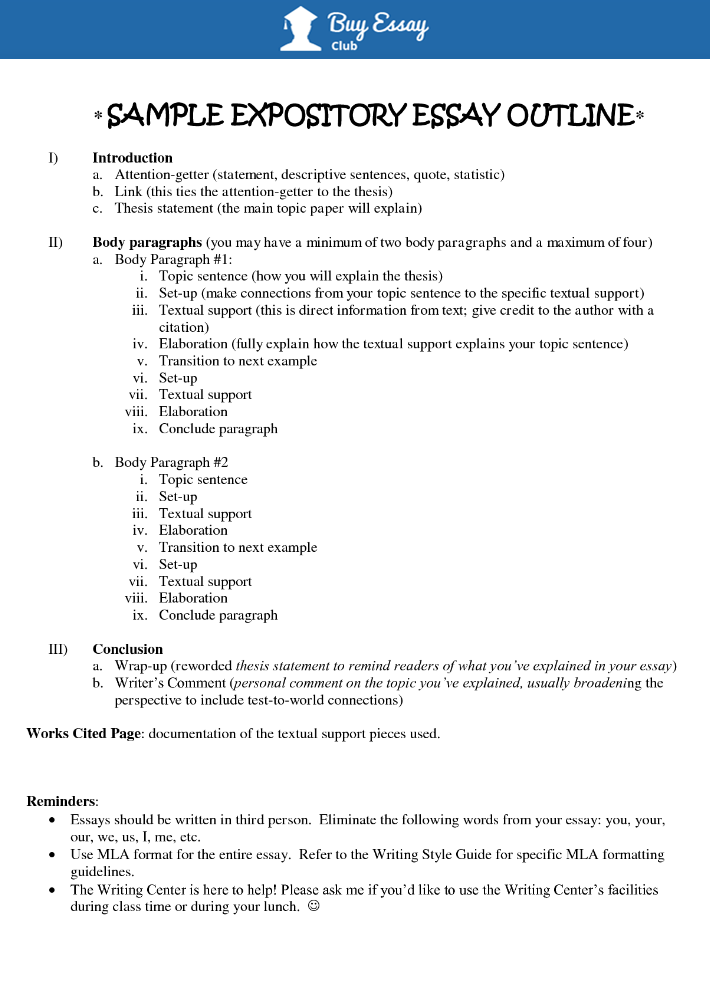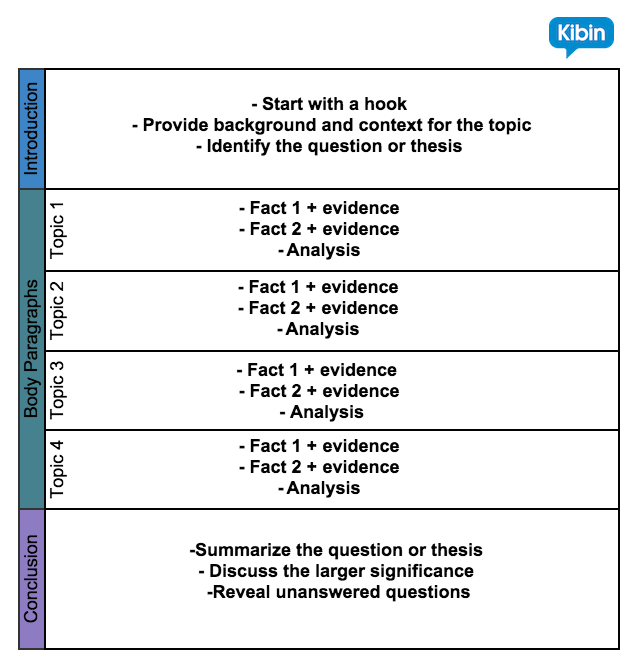
Expository Essay Outline Template Introduction Hook sentence Background and context for the topic Question or thesis Body Paragraph 1 Topic Sentence 1 Fact 1 supported with evidence Fact 2 supported with evidence Analysis Body Paragraph 2 Topic Sentence 2 Fact 1 supported with evidence Fact 2 s Expository Essay Outline. Traditionally, expository essays include five paragraphs: Introduction; Main Body Paragraph 1; Main Body Paragraph 2; Main Body Paragraph 3; Conclusion; This is a standard way to approach this type of paper, but you can add alterations if the task requires it Expository Essay Outline An outline helps in organizing information and keeping the essay in proper structure. It is like a blueprint of an essay which acts as a road map for you to craft a compelling essay. Before you start jotting down words on a piece of paper, you should craft an outline for your expository essay
How To Create An Expository Essay Outline - Complete Guide
Students are expository essay outline asked to prepare expository essays. Although it is one of the most common types of essays, it does not make it that simple, expository essay outline. An expository essay has a specific structure and requires students to apply their critical thinking skills to write an A-level piece, expository essay outline.
Getting a expository essay outline essay also involves having an organized and consistent writing process. Read on to learn how to write it outstanding with our expository essay writing service and get an excellent mark for it. An expository essay is a piece of writing that involves exploring a particular idea or issue, researching the existing evidence, and presenting a coherent and to-the-point argument, expository essay outline.
A writer should define concepts, exemplify the ideas, compare and contrast related phenomena, or provide cause-effect reasoning to reach the desired result. What differs an expository essay from other writing assignments is its goal. Thus, your objective is to inform the audience about a particular concept or view. Your argumentation must be based on hard facts, be simple, and explicit. Whether you write descriptively or draw a comparison, expository essay outline, you need to be unbiased.
Now that you know the expository writing definition, there is one more important aspect to consider: expository essays can be of various types, expository essay outline, which influences their structure and content. You need to know the differences between them to write a quality paper.
Commonly, there are six main types of expository essays:. This type of expository essay explains how to get something to work. It guides the reader through the stages of a certain process.
Process essays usually include the descriptions of steps and directions for the reader to follow. These can be expository essay outline instructions or recipes, for example:. Compare and contrast expository essays aim at discussing similar and divergent aspects of ideas, concepts, locations, or objects. To present your findings, you can use one of the following techniques : the alternating method, combination method, or block method.
The examples of a compare and contrast essay can include the following topics:. Working on this type of essay, you need to investigate the cause-effect relations of a particular event. This entails identifying and classifying the reasons and discussing the results.
The topics that fall within expository essay outline type are:. A problem and solution expository essay raises a relevant issue and analyzes it from different points of view. Having presented the problem, you need to develop a possible solution. For example, you can discuss:. Classification essays require a particular mastery of critical thinking as you need to categorize objects according to their distinctive features. Thus, these expository essay outline discuss the aspects of a certain broad topic in detail.
You should explain the reason for sorting items into categories and provide examples. The classification essays include such topics as:. This type of expository expository essay outline focuses on the definition of a term or concept. It entails providing a common dictionary definition in addition to less conventional interpretations.
You may add examples, explain the origin of the term, and refute the wrong understanding of the concept under discussion. For instance, you may discuss the following topics:. There are several text structures you can use to write an expository essay and present your arguments. The block structure and the chain structure are the two most common types. The block method implies that you discuss one subject at first, expository essay outline, and then you move on to another subject in a separate paragraph.
For example, such a structure of a problem and solution essay may be illustrated in the following way:. Expository essay outline, the chain structure allows you to discuss each aspect of the problem point by point, which is especially useful for longer papers.
However, both of these structures are a suitable expository essay format. You should choose the method you feel more comfortable with, expository essay outline. In general, these prompts help students to get started writing an expository essay, and they may be inspirational in nature. They have a more focused purpose, too, requiring students to research and explain a specific topic to meet an educational objective.
For instance, a descriptive essay can be assigned to a student to teach him to describe something such as a place, expository essay outline, a person, an experience, an object, or a situation.
A cause and effect essay prompt may compel a student to discuss the causes and effects of cheating at school, thus reinforcing the idea that he should avoid cheating. While the overall content of an expository essay will depend largely on the prompt, the student may have some freedom to choose the specific topic, or at least the angle; he wants to illuminate in the paper. For instance, he could explain the origin of a particular group of individuals in society; in such a case, the author should make the story as interesting as possible.
For a process essay, the writer could explain the process of digestion in a cow. A descriptive essay could describe a time when the writer experienced depression, as well as what he believes to be the cause of it. Lastly, the topic for a problem or solution essay could be how society can reduce or eliminate racism, using facts to expose the history of racism in specific communities.
Once you have expository essay outline out the type and structure of an expository essay you are going to write, you can move on to the next steps. As you may have deduced from the expository writing definition, this type of writing is based on the exploration of a certain idea and presentation of the findings to the audience. You should use simple and concise language as your primary goal is to explain the topic to the readers without confusing them.
Expository writing can be used in a blog post, newspaper article, scholarship essayand many more. At the same time, it is an opportunity for students to learn how to express themselves expository essay outline writing. Simply send us your requirements and get your polished paper in no time!
This is a standard way to approach this type of paper, but you can add alterations if the task requires it. Do not neglect to structure your essay as it allows you to organize your thoughts and present clear arguments to the reader. As with any other piece of writing, an expository expository essay outline should start with the introductory paragraph. Keep it short sentences but informative, expository essay outline.
In the first sentence, try to present the problem to the readers in an interesting way. This would be your hook. You should then write general information about the topic, mention why this issue is relevant, and outline the context in which you plan to discuss the problem.
This part must be engaging and compelling for the audience to become interested in your piece. Keep in mind that the introduction lays the foundation for the further development of your argument. You should incorporate a powerful thesis statement in the last sentence of the introduction.
When making this claim, ask yourself what you are trying to say with your essay. However, you should refrain from expressing your personal opinion. It is better to stay neutral and present only proven facts. Invest some extra time to make this sentence thoughtful and convincing. The body of the essay should explain your arguments. It must be the most detailed part of the text, so make it specific and do not add any fluff. Make sure that each body paragraph is focused on one particular idea or claim.
It would help the reader to stay focused and follow your line of argumentation without effort, expository essay outline. Typically, you would need to write three paragraphs.
Each of them must have the following outline:. A topic sentence should introduce the idea of the whole paragraph. Make it concise and clear. Do not forget that all topic expository essay outline you write should be connected with the thesis statement introduced in the first paragraph. It would be a good idea to use facts, examples, and statistics as evidence to support your claim. Make sure you cite the information from outside sources in the style that your assignment requires, such as MLA, APA, Harvard referencingetc.
Correctly cited and incorporated evidence will show the audience that the information you present is credible and trustworthy. It is best to have three points or pieces of evidence to support each topic sentence. Finish the paragraph with a concluding sentence to summarize the claims you expository essay outline made. Make sure that the body paragraphs are logically linked. Incorporate transitions either in the last sentence of the previous body paragraph or in a topic sentence of the following one.
Use linking words to make the text cohesive. The concluding paragraph should summarize the main points of your expository essay. You do not need to add any new information. Start by restating the thesis statement, but do not copy it. Then, summarize the supporting arguments and create a thought-provoking statement or question, making it the last sentence expository essay outline your paper. A successful writing process requires thoughtful preparation and planning.
Divide your work into five following stages. Before you start writing your expository essay, you need to select a topic and brainstorm ideas and possible arguments. If it is your school or college assignment, most probably you already have particular guidelines. Read what your teacher or professor wants you to do and see what ideas you can come up with regarding the topic.
Note them down. Make sure that you can fully cover the topic within the required word count limits, expository essay outline.
Expository Essay Example - Step by step
, time: 9:29How To Write A Expository Essay: Outline, Topics, Examples and Step-By-Step Guide | Edusson Blog

Expository essay outline The outline is like a blueprint; its function is to act as a guide that you can use to build a house, or in this case an essay. Without the outline the risk of straying off the subject increases. It’s needless to mention you get confused due to a Expository Essay - Outline · Expository Essay Outline Structure There is more than one way to pattern an expository essay, including sequential, cause and effect, compare and contrast, spatial, topical, and many other patterns. Since we’re writing about the effects of social media,

No comments:
Post a Comment